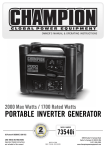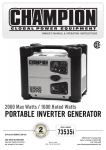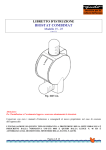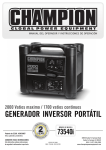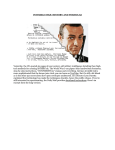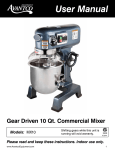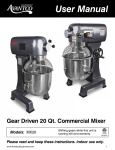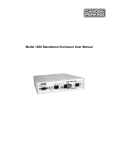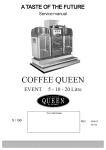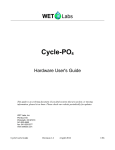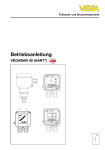Download Installation and Instruction Manual BiOSTAT 2000
Transcript
Installation and Instruction Manual Please keep in a safe place for future use! Please hand over to the operator. Read carefully before installing/ starting up! We reserve the right to make technical changes. BiOSTAT 2000 Type 25 E/110V Typ 50 E/110V 2 Manufacturer: Judo-Wasseraufbereitung GmbH Postfach 380, D-71351 Winnenden Hohreuschstrasse 39-41, D-71364 Winnenden Telephone: +49-*7195/6 92-0 Facsimile: +49-*7195/6 92-188 Type: Maintenance free descaler BiOSTAT 2000 Type 25 E/110V, Type 50 E/110V Model Part No. Type 25 E/110V 821 0316 Type 50 E/110V 821 0321 Judo Wasseraufbereitung provides a one-year guarantee/warranty for the function of these devices. Please ensure that you always precisely observe the details given in this manual, as otherwise any guarantee and liability claims shall expire. All figures, dimensions and design information were correct at the time of going to press. We reserve the right to make changes, which serve technical progress and further development. We are unable to accept any claims to a particular model and design. Instructions from Page 3 Machine number: ......................................................... 3 Dear Customer, Thank you for the trust you have shown in us by purchasing this device. With this descaler you have purchased a unit that is state of the art and with its test mark has proven that it is exemplary with respect to its effect, device safety and with respect to hygienic aspects. All the functions of this descaler were carefully and conscientiously examined before delivery. Should difficulties nevertheless occur, please contact your nearest customer service giving the device number 1 (see also Chapter “Malfunction, customer service"). Contents 1 General ........................................................................................................................ 5 1.1 Intended use .......................................................................................................... 5 1.2 Units and symbols used ......................................................................................... 5 1.3 Extent of delivery.................................................................................................... 6 1.4 Accessories............................................................................................................ 7 1.5 Shipping brace ....................................................................................................... 8 1.6 Field of application ................................................................................................. 9 1.7 Use limitations........................................................................................................ 9 2 Safety ......................................................................................................................... 10 3 Technical Data ........................................................................................................... 11 4 Installation Location Requirements ............................................................................ 12 5 Installation .................................................................................................................. 14 5.1 Installed dimensions and weights ........................................................................ 14 5.2 Assembly.............................................................................................................. 14 5.2.1 Installation of the connecting flange JUDO Quickset E (JQE):....................... 15 5.2.2 In-line arrangement of a Quickset-X single-lever bypass valve (JQX), only for Type 25 E:.................................................................................................................. 16 5.2.3 Install descaler ............................................................................................... 16 5.2.3.1 Install Type 25 E (1“): ............................................................................... 16 5.2.3.2 Install Type 50 E (1 ½“): ........................................................................... 17 6 System in operation ................................................................................................... 19 6.1 Functional description .......................................................................................... 19 6.2 Commissioning..................................................................................................... 20 6.3 Operation ............................................................................................................. 22 6.4 Interruption, shutdown.......................................................................................... 22 6.5 Flushing................................................................................................................ 23 6.6 Cleaning ............................................................................................................... 23 7 Description of the Electric Controls ............................................................................ 24 7.1 Display, keyboard................................................................................................. 24 7.2 Status display....................................................................................................... 25 7.3 Menu overview: .................................................................................................... 26 7.4 Description of the sub-menus .............................................................................. 28 7.4.1 Operating data ............................................................................................... 28 7.4.2 Water consumption Page 1 ............................................................................ 28 7.4.2.1 Menu: Water consumption previous year................................................. 28 7.4.2.2 Menu: water consumption page 2 ............................................................ 28 7.4.3 Diagrams........................................................................................................ 29 7.4.4 Settings .......................................................................................................... 30 7.4.4.1 Date/ Time................................................................................................ 30 1 The number of this device is noted down on the first page of this manual. Also it is engraved in front of the device and visible after lift up the cover. 4 7.4.4.2 Unit data ................................................................................................... 30 7.4.4.3 Language selection .................................................................................. 31 7.4.4.4 Display...................................................................................................... 31 7.4.5 Flushing.......................................................................................................... 32 7.4.5.1 Flushing interval time ............................................................................... 32 7.4.5.2 Flushing interval – water quantity............................................................. 32 7.4.6 Customer service ........................................................................................... 33 7.4.6.1 Change customer service data................................................................. 33 7.4.6.2 Event minutes........................................................................................... 33 7.5 Hoppla function .................................................................................................... 33 8 Warning messages .................................................................................................... 34 8.1 Notes on flushing the treatment chamber ............................................................ 34 9 Malfunction, customer service.................................................................................... 35 9.1 Malfunction........................................................................................................... 35 9.2 customer service .................................................................................................. 36 10 Spare parts list BiOSTAT 2000 E............................................................................ 39 11 Table for entering the Telephone Number and the Customer Service Firm ........... 40 5 1 General 1.1 Intended use The BiOSTAT 2000 reduces the tendency of the water to precipitate surplus lime and thus protects water pipes and hot water heaters against limescale deposits, which inhibit the flow of water and lead to a high power consumption. The devices and fittings are spared and thus expensive repairs are avoided. Lime edges and water stains are easier to wipe off. The types 25 E and 50 E have been tested by the DVGW (Deutsche Vereinigung des Gas- and Wasserfaches e.V. – German Gas and Water Association) in accordance with the requirements of the DVGW code of practice W 512 and the DVGW regulations 8-9/100 and 8-9/4-99 and exceed the minimum requirements for the effect, safety and compatibility of the plastics, some by significant amounts. They are therefore entitled to bear the DVGW mark. In addition to the descaling function the display can be used to enquire the operating data, the water consumption and the customer service address. The system settings and the flushing interval can be entered. 1.2 Units and symbols used The following symbols are used in this manual for improved clarity and understanding: ! ! Warning! This symbol indicates an item, which must always be observed for reliable operation or for safety reasons. Important! This symbol denotes tips for use and other useful information. Deviating from the official SI units, the following units and terms are used: Unit bar Conversion 1 bar = 105 Pa = 0.1 N/mm2 Unit Inch Conversion 1“ = DN 25 1 ½“ = DN 40 6 1.3 Extent of delivery Type 25 E Installation and instruction manual Type 50 E Installation and instruction manual Ready assembled device Device left (with display), Device right (without display), both devices are joined with the preassembled bypass valves (JQX) via the tandem piece (JQT, see Figure). Cable for connecting the two sets of electronics. Wall bracket for Type 50 JQT 7 - Connecting flange for Type 25 E: JQE 1” with screwed connection JQE mV - Connecting flange for Type 50 E: JQE 1 ½“ with internal screw thread JQE -Wall bracket and Raw plugs For Type 25 E: 1x For Type 50 E: 2x 1.4 Accessories For Type 25 E: JQR Quickset extension for series connection of two water treatment devices (e.g. filter and descaler). JQX single lever bypass valve Part No. 8250041 Part No. 873 5210 8 For Type 25 E and Type 50 E: Connection cable for external, potential free fault signal, Part No. 221 0244. The electric circuits of the Types 25 E and 50 E contain a relay with changeover function for potential-free transmission of the fault signal. It has the following control statuses: -for operating voltage “On“ picked up -for operating voltage “Off“ or malfunction released Loadability: 24V / 0.5A To connect the potential-free fault signal, insert the polarised connector in the socket labelled with “ext. Störmeld.“. The socket is located on the underside of the electronics, in Type 50 E it is located on the underside of the left-hand electronics. For operating voltage “On“ the connection in the relay between the white and green cables are closed, for operating voltage “Off“ or malfunction, the connections in the relay between the green and brown cables are closed. 1.5 Shipping brace The BiOSTAT 2000 Type 25 E/ Type 50 E is screwed onto a wooden board to protect it from transport damage. This board must be dismantled by removing the two crosshead screws before the device is installed. A white plastic cover protects the sealing edges of the connecting flange (JQE) and prevents dirt from penetrating. This cover must also be removed before installation. 9 1.6 Field of application Type 25 E/110V The output of this system is designed that it is sufficient for a detached house with up to 6-8 people. Up to 40 litres of treated water per minute are available. Type 50 E/110V The output of this system is designed so that it is sufficient for multiple unit housing, large residential units and office buildings. Up to 80 litres treated water per minute are available. 1.7 Use limitations ! This descaler has been developed for use in cold drinking water, which complies with the German Drinking Water Ordinance. The manufacturer must always be consulted before installing the descaler in other media than water or in water with additives! The descaler can be used in the whole drinking water sector as long as the water to be treated is not aggressive to lime. ! In case of mains pressures above the max. operating pressure of 8 bar (even for short periods) a pressure reducer must be installed upstream of the device. ! In case of mains pressures above 7 bar, we recommend that you install a pressure reducer upstream of the device. The BiOSTAT 2000 must not be installed in circuits/loops. 10 2 Safety The materials and protective covers used are resistant to the physical, chemical and corrosive stresses to be expected in the water. All materials, protective covers and resources are hygienically and physiologically safe. Plastics and non-metallic materials fulfil the requirements of the Federal Health Office (KTW recommendations). ! This descaler has been developed for use in cold (up to 30°C) drinking water (water from the municipal water supply). The manufacturer must always be consulted before installing the descaler in other media than water or in water with additives! ! The water to be treated must not contain substances with a marked polar character, such as alcohols, concentrated mineral acids, formic acid, phenol, m-cresol, tetrahydro furan, pyridine, dimethyl formamide and mixtures of chloroform and methanol. They lead to brittleness through to fracture of the plastic parts. Only gentle soap solutions or water may be used for external cleaning. The operating and maintenance instructions specified in this instruction manual must be strictly observed. Independent modifications and changes are prohibited for safety reasons! The test marks printed on the devices are only valid when original Judo parts are used. The mains voltage of 230 V is transformed to a safe extra-low voltage of 24 V with the aid of a completely encapsulated power pack (Class of protection IP 65). The electronic housing must only be opened by trained qualified personnel after the mains plug has been removed from the socket. The main power cable must only be completely replaced with the power pack by the manufacturer, the manufacturer’s customer service or qualified trained personnel. 11 3 Technical Data Rated pressure: The rated pressure denotes the maximum pressure, up to which the safety of the device has been tested. The maximum operating pressure is lower, to ensure optimum function. Type 25 E/110V Type 50 E/110V Rated flow 2.5 m3/h 5 m3/h Pipe connection 1“ 1 ½“ Nominal pressure PN 10 PN 10 Operating pressure max. 8 bar 8 bar Pressure loss for rated flow 0.4 bar 0.5 bar Electrical connection 230 V/50 Hz 2 x 230 V/50 Hz Max. power consumption 120 W 240 W Max. ambient and water temperature 30°C 30°C 12 4 Installation Location Requirements ! To be able to ensure trouble-free operation, the requirements named in the following must be complied with. A shut off valve must be installed upstream of the device. To protect the descaler against dirt, a protective filter should be installed upstream of the system (back washable or as tube filter) with a mesh size not larger than 0.1 mm. The mains pressure should not fall below 1.5 bar, as other wise the rinsing can be impaired. In the case of mains pressures above the max. operating pressure of 8 bar (pressure peaks during the night must also be noted!) a pressure reducer must be available upstream of the device. Pressure reducers are available as individual devices or in combination with a protective filter. The room used for the installation must be dry and frostproof. Unauthorised persons should not have access to the room. The ambient temperature must not exceed 30 °C. Avoid direct insolation. The device must not be exposed to any strong impacts. The device can be installed in each flow direction in all proprietary drinking water pipes. Please note the cast in flow direction arrow on the connecting flange. A socket (230 V, 50 Hz) is required for operation of the BiOSTAT 2000 Type 25 E. Two sockets are required for the Type 50 E. The sockets must not be able to be switched off by a light switch or similar. The length of the power cable is approx. 1.5 m. For the case that major damage could occur at the installation location due to a leak in the device or the feed pipe (e.g. in offices, doctor’s practice, etc.), it must be ensured that the water and current supply are interrupted upstream of the device when the personnel are absent. Alternatively, the central water monitoring fitting, the Judo Zewa Water Stop (Part No. 8140002) can also be installed upstream of the descaler. It monitors the water flow for unwanted tapping/removal and shuts down the water according to the parameters set when necessary. The installation height depends on the pipe route, the minimum overall height from the floor to the rotating flange: 645 mm. The flushing water can be fed to an outlet or be collected in a bucket. Discharge with a free outlet to DIN 1988 can also be above the device. 13 An adequately dimensioned wastewater connection (e.g. floor drain) to DIN 1986 must be available for the flushing water. The dimensioning is oriented to the local circumstances (e.g. wastewater pipe longfall, number of changes in direction, length of the wastewater pipe, etc.). However it must also be large enough that all the flushing water can be carried away at the same time. The extent of delivery of the BiOSTAT 2000 Type 25 E/Type 50 E includes a wall bracket (see p. 6), which prevents the device from twisting, but does not hold its weight. The water pipes should therefore be supported at the connecting flange with two pipe clips, especially in case of small pipe cross-section and soft pipe materials. The extent of delivery of the BiOSTAT 2000 Type 50 E also includes a wall bracket, which takes the weight of the device. Keep to the given installation spacings (at least 100 mm to the top and below) to ensure comfortable operation and servicing. 14 5 Installation 5.1 Installed dimensions and weights Device dimensions (mm) Type 25 E/110V Type 50 E/110V A = Depth to centre of pipe (without/with JQX1)) B = Width 243/308 -/330 330 525 5.2 Assembly The devices are DVGW tested, i.e. they can be connected without a safety fitting (e.g. pipe disconnector). 1) JQX (by-pass) for Typ 25 E/110V as accessories available, for Typ 50 E/110V standard aquipment. Part-No. 873 5210 15 5.2.1 Installation of the connecting flange JUDO Quickset E (JQE): The JUDO Quickset E (JQE) is used as a connecting element between many Judo devices and the domestic water installation. It is the flange connection between the water pipe and the descaler. The JQE 1“ with screwed connection (mV) for the Type 25 E consists of the rotating flange with external thread, union nut, pipe sockets with external thread, ring seal and assembly cover. The connection width for the Type E is specified at 1” by the pipe sockets. The rotating flange must be suitable both for horizontal as well as vertical pipes, and must be installed in the direction of flow. This is denoted by a cast in arrow. The flange surface or the rotating flange must be vertically upright. The pipe can be tested for leaks before the BiOSTAT 2000 is installed. JQE mV The JQE 1 ½“ with internal screw thread for the Type 50 E consists of the rotating flange with internal screw thread, ring seal and assembly cover. The rotating flange, suitable both for horizontal and vertical pipes, must be installed in the direction of flow. This is denoted by a cast in arrow. The flange surface of the rotating flange must stand vertically. The pipe can be tested for leaks before the BiOSTAT 2000 is installed. JQE The ring seal between the rotating flange and connecting flange of the BiOSTAT 2000 must be installed so that the shaped side points towards the rotating flange. If there are no impressions in the rotating flange for these raised surfaces, e.g. as can be the case in older rotating flanges, the flat packing included in the accessories bag must be used as a ring seal. 16 5.2.2 In-line arrangement of a Quickset-X single-lever bypass valve (JQX), only for Type 25 E: (Accessory Part No. 873 5210) The JQX allows easy decoupling of the connected descaler from the pipe network, without the water supply being interrupted for the consumers. The JQX does not have a bayonet connection. Therefore the cheese head screws M6x88 in the descaler’s flange must be replaced by the threaded rods in the accessories bag. A section flange seal with four screws and nuts is prefitted to the flange of the JQX denoted by the cast in letter >>R<< (pipe). Screw this flange to the JQE rotating flange. Screw the BiOSTAT 2000 to the other flange with the cast in letter >>G<< (device) using the nuts from the accessories bag. Fit the JQX so that the hand lever either stands pointing upwards or to the side. The installation should be carried out so that the hand lever is easily accessible according to the local circumstances. In the >bypass< setting the BiOSTAT 2000 is separated from the water mains and can be flanged off by the bypass valve. To make switching from >operation< to >bypass< easier, open the test valve (W) briefly so that the pressure in the device falls. W JQX JQE 5.2.3 Install descaler 5.2.3.1 Install Type 25 E (1“): Before the installation, remove the shipping brace (see Chapter “Field of application“): • Remove the wooden panel by removing the two cross head screws, • Remove the white plastic cover by undoing the four screws in the flange of the BiOSTAT 2000 (do not completely remove!), until the cover can be removed by rotating it in a clockwise direction. This shipping brace protects the flange from damage when the device is dismantled. The wall bracket (Part No. 220 0500, refer to the enclosed installation instructions) can bet fitted between 200 and 290 mm in the middle below the JQE (measured from the middle of the pipe). 17 Connection with bayonet: Remove the assembly cover of the JQE. Insert the device with the 4 screws in the bayonet drill wholes of the rotating flange. Turn the device in a clockwise direction until it stops and then tighten the screws. Connection without bayonet: Undo the cheese head screws M6x88. Then replace the cheese head screws with the threaded rods included in the accessories bag. Remove the assembly cover of the JQE. Insert the threaded rods in the connecting flange of the descaler through the ring seal and the holes in the connection piece (e.g. JQE) and then tighten them using the nuts from the accessories bag. 5.2.3.2 Install Type 50 E (1 ½“): Before the installation, remove the shipping brace (see Chapter “Field of application“): • Remove the wooden panel by removing the two cross head screws, • Remove the white plastic cover by undoing the four screws in the flange of the BiOSTAT 2000. This shipping brace protects the flange from damage when the device is dismantled. The Type 50 E consists of two treatment devices, which are connected in parallel via a tandem piece (JQT). Two single lever bypass valves (JQX) are fitted to the tandem pieces (triple flange) are preassembled as a standard (see Figure). Left-hand device with display Right-hand device without display 18 Unscrew the assembly cover from the JQE. Hold the JQE bracket immediately in the middle below the rotating flange of the JQE 1½“. Draw the drilling holes and drill the hole so that the Rawl plug no longer protrudes. After drilling the bracket is placed to the side. Screw the triple flange (T-piece) to the rotating flange 1 ½“ with the two preassembled JQX. To do this you can use the screws and the ring seal, with which the assembly cover was fixed to the rotating flange. Then the JQE bracket can be fitted using the hexagonal screws supplied 8x60 and the Rawl plugs ∅ 10 mm. To prevent twisting, fit the two wall brackets (No. 220 0500, read the enclosed installation instructions) between 200 and 290 mm beneath the JQE (measured from the middle of the pipe). The spacing on both sides should be around 20 cm from the middle of the rotating flange. The Type 50 E is equipped with threaded rods in the connecting flange as a standard. Use the section flange seals supplied and the nuts to fit it to the flange of the left-hand JQX of the BiOSTAT with display, to the flange of the right-hand JQX of the BiOSTAT without display. Then connect the two sets of electronics using the enclosed connection cable. The cover hoods do not have to be removed to insert the cable, as there are recesses in the panelling at the appropriate locations. The connecting sockets are located to the right next to the electronics’ housing. 19 6 System in operation 6.1 Functional description The BiOSTAT 2000 is fundamentally different from other water treatment devices available on the market. It releases extremely small seed crystals, on which the lime can deposit itself. The following processes take place: In the treatment space there is an anode coated with a precious metal (plus pole) and the cathode (minus pole) is made from round stainless steel brushes. As soon as water flows, a pulsating direct voltage is applied to these two electrodes, a current flows between the electrodes. The dissolved lime deposits on the cathode (the round stainless steel brushes) in the form of calcium carbonate crystals. At the same time this lime that has deposited on the round brushes is removed again by rotating stripper around the brush circumference – by bending and subsequent acceleration of the brushes. The crystals formed in this way are minute micro crystals. Any larger crystals that have formed sink to the floor and can be removed via the drain tap by regular flushing. They can be seen in the flushing water as very fine “sand“. The aforementioned microcrystals remain in suspension and function as seed crystals, on which lime can deposit. Above all in hot water areas, the growth can be identified by the slight turbidity of the water. The crystals grow and slowly become of a size in which they scatter light. They are then thousandths of a millimetre in size. But even these crystals are still so small that they remain in suspension and are flushed out with the current. The same procedure takes place in cold water only the lime depositing potential is normally much smaller. As the surplus lime now deposits on the seed crystals, other surfaces (pipes, boiler, etc.) mainly remain free of limescale deposits, e.g. electric heating rods. The formation of the crystals reduces the hardness of the water slightly. This reduction is so slight that it cannot be detected using simple measuring equipment. In the device’s inlet there is an impeller wheel water meter, which detects even very small flows of around 0.5 l/min. Together with microprocessor-controlled electronics it ensures that depending on the water composition, the current pulses can be adjusted so that optimum water treatment always takes place, from very small flows through to the nominal flow. The stripping of the microcrystals from the cathode and the flushing of larger lime crystals via the drain tap means that the cartridge does not have to be regularly replaced. The operating data and the water consumption in the household can be enquired at the display, the adjustments to the system can be made, flushing intervals specified and the address of the customer service enquired. The description of the display function is given in the Chapter Description of the electric controls. 20 6.2 Commissioning Mains “ON“ 1.Commiss ioning ? No Self-test Yes Display: JUDO water treatment approx. 3 seconds Enquiry and enter the language Message: BiOSTAT OK approx. 1 second or error message Enter: -Assembly by a specialist firm Yes/ No -Commissioning by specialist firm / Judo -Date / Time Status display No ! Key menu 2s confirmed? Yes Main menu For safety reasons the descaler must be vented immediately after being connected to the water network (bypass valve in operating position). Opening a water tap downstream of the device does this. 21 Insert the mains plug in the socket (in the case of Type 50 E both plugs). The mains plugs must be freely accessible. After connecting the power supply the switching carries out a test of all the functions and parameters stored in the electronics. After completing the self test the display “BiOSTAT OK“ appears for approx. 1 second. If a malfunction has been detected the error is displayed. In addition the red LED is continuously lit indicating the malfunction too. When starting up for the first time/commissioning the following display appears after the self-test has been carried out: ** Sprachauswahl deutsch English espanol francais italiano nederlands continue ** ü The language currently set is indicated with a ü. If another language is to be set the bar must be moved to the required language using the After confirming with key. this input is accepted. >OK The following display then appears: ** First start-up ** ASSEMBLED by qualified craftsman: Please enter whether the installation has been carried out by a qualified craftsman. Please confirm using the appropriate function key. ß YES ß NO The following display then appears: **First start-up** FIRST OPERATION by qualified craftsman: Please enter whether the commissioning is being carried out by a qualified craftsman. Please confirm using the appropriate function key. ß Yes ß No **First start-up** FIRST OPERATION by JUDO: ß Yes ß No If you answered the previous menu with “No“, the enquiry to the left appears. Please confirm with “Yes“, if the commissioning is being carried out by JUDO, or “No“, if the commissioning is being carried out by a private person. 22 In the final commissioning display window you can enter the current date or time. Change: Date/Time Date: 03.11.00 _OK Time: 13:05 _OK back >OK The current date of the internal clock at the time the first water is drawn off is stored as the commissioning date. The status display (see Chapter “Status display”) If the device is restarted following a shutdown (or even after a power failure), proceed as for the first commissioning. Please note that the language selection and the commissioning and installation inputs no longer appear. After the self-test has been carried out on the electric circuit without errors the display changes directly to the display mode “Status display“, the system is ready to run. 6.3 Operation To adjust the treatment effect to the water flow and thus optimise the effect, the BiOSTAT 2000 is equipped with a water meter for precise flow measurement. The water meter delivers electric impulses to the BiOSTAT 2000’s controls. The electronics recognises from the frequency of the impulses how must water is flowing and adjusts the treatment current accordingly. The electronics deduce from the level of the treatment flow what the water composition is and optimises the treatment current accordingly. Depending on the water composition and operating mode a small quantity of sand-like lime particles form in the treatment area as well. To flush these out, the BiOSTAT 2000 should be flushed every 3 - 6 months depending on the water consumption (see Chapter “Flushing„). 6.4 Interruption, shutdown If the water supply to the descaler is interrupted (main tap closed or bypass open), the system’s mains plug must also be removed from the socket. A dismantled system must be stored in a dry, frostproof place. The connecting flange must be protected against soiling and damage. The white cover can be used for this (see Chapter „Shipping brace“). 23 If a dismantled system is reinstalled and restarted, the system must always be vented by opening a water tap downstream of the device. If the device is restarted after a shutdown (or even after a power failure), then proceed as for the first commissioning/start up. Please note that the language selection and the inputs for the commissioning and installation no longer appear. After the self-test has been carried out on the electric circuit without errors the display changes directly to the display mode “Status display“, the system is ready to run. 6.5 Flushing As there are no consuming or blocking components in the system, no regular maintenance is needed. You only have to flush out any sand-like lime particles that may have formed, every 3 - 6 months, see also Chapter “Operation“ and the relevant chapter in the sub-menu. To flush the system, open the ball valve at the lower end of the panelling and allow around 3 litres of water to flow out. If you collect the flushing water in a bucket, you can see how much lime has been flushed out. If there is an easily visibly covering of the base of the bucket, the flushing interval should be reduced. If the flushing water only contains a little lime, the flushing interval can be extended or retained. ! In the case of high network pressures and fully opened ball valve the water can splash out of the bucket. In such a case close the ball valve a bit. You can also connect a hose to the ball valve. The hose must be firmly connected with the wastewater connection to prevent a wagging pressure. Please also read the Chapter 6.5“, here you can enter the various time intervals until the next flushing. The display reminds you that flushing is due after the given time has expired. If a flushing is carried out outside of the given time interval, this should be entered in the Chapter “Flushing“. The given time interval starts again from new. 6.6 Cleaning The external surfaces of the device can be cleaned with a normal household soap-based cleaner (soft soap). ! Solvents, solvent vapours, varnishes and cleaners containing alcohol lead to brittleness and to severe surface crack formation through to fracture of the plastic parts. ! Standard household all-purpose cleaners and glass cleaners can contain up to 25% solvent or alcohol (methylated spirits). Such cleaners must not be used! 24 7 Description of the Electric Controls 7.1 Display, keyboard The operating data and water consumption can be enquired via the display and the system settings changed, the flushing intervals can be specified and the customer service address enquired. The following is a description of this device’s keyboard: Power Alarm 1 2 ABC 3 DEF 4 GHI 5 JKL 6 MNO 7 PQRS 8 TUV 9 WXYZ * 0 # F1 F2 F3 Menu Menu Back Back OK Use this key to change from the status display to the main menu. Press briefly = one menu step back Press continuous (approx. 3 seconds): = back to the status display Page down in the menu field. The momentary line of text is shown in inverse colours (light coloured writing on a dark background) The following functions are possible: OK >OK -OK For menu lines with the end symbol “>OK“, press submenu denoted by the bar to jump into the For menu lines with the end symbol “_OK“ the values or data shown in these menu lines can be overwritten. After pressing the changed data is accepted. 25 The alphanumeric keyboard can be used to change or enter new values in the menu lines marked with the end symbol “_OK“. When entering letters the relevant key has to be pressed briefly several times. E.g. to enter an “s“ press the key 4x briefly and consecutively. In addition to the characters printed on the keyboard other symbols can be used when entering the telephone number and name of the firm. These characters are listed in the Table Tab1 on the left-hand side. The changed data is accepted after pressing . For menu lines with the end symbol “_OK“ this key can be used to move the cursor along the line to be changed. For menu lines with the end symbol “>OK“ this key can be used to select the value shown from a specified list. F1 The function keys F1.F3 are required in several menus to select the possible inputs. The precise meaning of these keys is described on the display. F2 F3 LED Green “Power“: device is connected to the power supply (230V). Red “Alarm“: there is a fault signal or warning message. 7.2 Status display After the self-test has been carried out without errors, the display changes into the display mode “status display“. The following image appears on the display: In the 1st line the name of the water treatment device appears. The 2nd line shows the momentary water flow in l/min. waterflow: There is a picture of a water tap in the middle. While water is being taken from the system the short lines within the water pipe move to the right. The bottom line shows the number of litres of water currently being drawn off through the system, inside the pot symbol. waterquantity: The water flow quantity displayed is reset to zero 15s after the water is no longer drawn off. The value of the water quantity is reset to zero after 40 seconds. After pressing you come to the main menu of the BiOSTAT 2000. 26 Main menu By pressing the key you arrive in the main menu of the BiOSTAT 2000 E. Operating data >OK Water consumption>OK -Diagrams >OK Settings >OK Flushing >OK Customer service >OK Page with the key and then press the key reach the sub-menu marked by the bar. to Operating display>OK Use the key or the bottom line in the menu “operating display“ to arrive back in the operating display. The various sub-menus are described in the Chapter “Description of the sub-menus“. 7.3 Menu overview: To get from the status display to the main menu, press . From there you can select the following sub-menus: Operating data (Chapter 7.4.1) Water consumption Page 1 (Chapter 7.4.2) Diagrams (Chapter 7.4.3) Settings (Chapter 7.4.4) Flushing (Chapter 7.4.5) Customer service (Chapter 7.4.6) By pressing you move back from the main menu to the operating display. The following page shows the flow diagram with the general display functions (Menu overview). 27 Flow Diagram – General Display Functions – Menu Overview Operating data: 7.4.1 Operating display 7.2 Main menu 7.2 Water consumption 7.4.2 Consumption diagrams 7.4.3 Settings 7.4.4 Operating data: - Total water quantity - Operating time - Treatment time 7.4.1 Water consumption: - Previous year - Current year - Current month - Present day - Comparison with same month last Date/Time 7.4.4.1 Device type Device number Version number 7.4.4.2 Language 7.4.4.3 Display 7.4.4.4 Flushing 7.4.5 Flushing interval - max. time - max. water quantity 7.4.5 Carry out next flushing on: 7.4.5 Customer service 7.4.6 Customer service address: - Name - Phone number 7.4.6 Commissioning 7.4.6 Event log 7.4.6 Diagrams - Current year - Previous years - Current month - Previous months 7.4.3 Change: - Date - Time Change language: - German - English - French - Flemish - Italian - Spanish Display settings: - Contrast - Background lighting Change Customer service address: 7.4.6.1 Commissioning: - Date - Installation by - Commissioning by 7.4.6.1 List - Flushings - Fault messages 7.4.6.2 28 7.4 Description of the sub-menus 7.4.1 Operating data ****Operating data **** Total water quantity: 175 m3 Operating time: 350 days Treatment time: 160 h back >OK In this the accumulated operating data over the whole operating period of the BiOSTAT is displayed. Total water quantity: Total water quantity to flow since the BiOSTAT was started up /commissioned for the first time. Operating time: Total time since the commissioning Treatment time: Total time that the treatment current has flown in the BiOSTAT. For the Type 50 E the values displayed are the sum of the measured values from both devices. 7.4.2 Water consumption Page 1 Water consumption:P.1 Last year 175 m3 >OK This year 259 m3 This month 11.4 m3 Today 521 litre To page 2 back The water consumption values are displayed here related to the various time intervals. The water consumption of the previous year in line 2 can be changed by selecting the line and pressing the key (see Chapter “Menu: Water consumption previous year“). >OK >OK 7.4.2.1 Menu: Water consumption previous year After selecting the menu line “change“ the total water consumption for the previous year (see water consumpChange: tion billing) can be re-entered or changed. Water consumption This is only interesting in the first year of commissioning, Last year 175 m3 as otherwise there are no comparative values in the “water consumption“ to compare with. This menu no longer Change m3 appears from the following year. _OK If a value is entered here, an average consumption value is calculated which is used for the water consumption back >OK diagram up to the day until the commissioning. 7.4.2.2 Menu: water consumption page 2 Here the water consumption of the last month can be Water consumption:p.2 compared with the water consumption of the corresponding month in the previous year. Compare with water consumption of last year (last 30 days) back -5.7% >OK 29 7.4.3 Diagrams ******Diagrams****** Month: 02/2001 ß Month back Year: 2001 ß Year back back >OK >OK >OK After selecting the menu line “Diagrams“ you can use the F2 and F3 keys to select a monthly or annual diagram. Each time a function key is pressed the screen changes to the respective previous month or year. The key can be used to switch between the monthly and yearly diagrams. The F2 and F3 keys can also be used to directly switch between the annual diagram and the monthly diagram. The selected diagram flashes and is shown after you press the key . Example: monthly diagram Taken The values are shown in litres. The maximum value is 2500 litres. The scaling is calculated depending on the largest consumption value. The monthly diagram data for the last 14 months are permanently stored in the EEPROM. Example: monthly diagram Taken Use the key The values are shown in m3. The maximum value is 99 m3. The scaling is calculated depending on the largest consumption value. The yearly diagram data for the last 10 years are permanently stored in the EEPROM. to display the respective previous diagram. Use the key to return back to the “diagrams“ menu or the key back to the main menu. to return 30 7.4.4 Settings **** Settings **** Date: 03.11.00 >OK Time: 13:05 >OK Unit data >OK Language: english >OK Display >OK back >OK By selecting the lines “Date“ or “Time“ your reach the “Date/ Time“ menu for changing this data. By selecting the line “device data“ you arrive in the “Unit data“ menu for displaying the exact device name. By selecting the line “language“ your arrive in the menu for changing the language of the text displayed. The currently set language is displayed. By selecting the line “Display“ you arrive in the “Language selection“ menu for changing the display setting 7.4.4.1 Date/ Time The current date or the time can be entered in the last commissioning display window. Change: Date/Time Date: 03.11.00 _OK Time: _OK 13:05 back >OK 7.4.4.2 Unit data ****Device data**** Type: BiOSTAT 2000-25 E Device No.: 12134 Version 1.0/0210/c MMT: not inst. back >OK The exact data for identifying the treatment device is displayed in this window. 31 7.4.4.3 Language selection ** Select Language** deutsch English ü espanol francais italiano nederlands The currently set language is marked with a ü. If you want to set another language, use the key to move the bar to the required language. Confirm with to accept this input. 7.4.4.4 Display ***** Display ***** The display menu shows the contrast and lighting display. Contrast: 50% >OK the illumination 100%: >OK After selecting and confirming with the key respective set value can be changed using the afterglow time 4 Minutes >OK respective function keys. back >OK 7.4.4.4.1 Contrast setting The function key F2 can be used to increase the contrast, the function key F3 is used to reduce it *Contrast setting* Contrast 50 % ß plus ß minus back >OK 7.4.4.4.2 Background lighting - intensity *** *** Background lighting illumination ß plus ß minus Back *** *** 50 % >OK The function key F2 can be used to set the background lighting lighter, with the function key F3 it becomes darker. 32 7.4.4.4.3 Background lighting persistence *** Background *** lighting reducer after 4 Minutes ß plus ß minus back *** *** The function key can be used to extend the persistence (i.e. how long it continues to light) of the display background lighting, the function key reduces it. >OK 7.4.5 Flushing The time interval until the next flushing of the treatment ***** Flushing ***** chamber can be entered here as well as the max. quantity Flushing interval: of water until the next flushing. - time 2 Months >OK Based on the average water consumption the screen then displays when the next flushing should take place. The - water qty 100 m3>OK minimum time of one month cannot be reduced. next flushing If a flushing is carried out before this time has expired for due on: 60days ß execute flushing the BiOSTAT Type 25 E or 50 E the key must be Back >OK pressed. To check whether flushing has actually been carried out approx 0.5 l water must have flowed in the period of 3 minutes before or after pressing this key. After this condition has been fulfilled the next flushing date is calculated. 7.4.5.1 Flushing interval time Change flush.interval By setting the bar on the line “time“ and confirming with time until flushing: the key you arrive in this menu. 1 Month Here you can enter the time intervals until the next flush2 Months ü ing. Set the bar with the key on the required interval and 6 Months 9 Months . confirm with the key 12 Months back >OK 7.4.5.2 Flushing interval – water quantity Change flush.interval W.qty. until flushing 10 m3 50 m3 100 m3 ü 3 150 m 200 m3 back >OK By setting the bar on the line “Water qty“ and confirming with the key you arrive in this menu. Here you can enter the quantity of water until the next flushing. Set the bar with the key on the required interval and confirm with the key . 33 7.4.6 Customer service * Customer service frm. Judo GmbH phn. 07195/692-116 Change ? * >OK Events protocol Start-up Back >OK >OK >OK The data important for the customer service is displayed here. The name and telephone number of the firm responsible for customer service is shown in the lines 2 and 3. This data can be changed after selecting the relevant menu line in the menu ”Change customer service data“. After selecting the menu line “Event minutes“ you arrive in the menu.“ Event minutes “ 7.4.6.1 Change customer service data ** Change customer ** ** service data: ** frm. Judo GmbH _OK phn. 07195/692-116 _OK back >OK 7.4.6.2 Event minutes *Eventprotocol 1* A list of the events important for the customer service is Error 3 displayed here in the order they occurred. Date: 09.10.00 The following is displayed: Time: 09:30 Malfunction mesage with fault number. Flushing Date and time of the malfunction messages Executed Yes Warnings e.g. note of the flushing of the treatment Date: 22.12.00 chamber with date and time. Time: 07:44 Note, whether e.g. a required flushing has been carback >OK ried out. The event log can be up to 5 pages long. If further events occur, the respective oldest page is deleted. The key can be used to page down in the event log. 7.5 Hoppla function By pressing the key and the key “*1“ the contrast is reset to the standard value of 30 % then the screen jumps back to the language selection menu. This function is used if the display has become illegible due to incorrect contrast entries or the wrong language is selected. 34 8 Warning messages Warning messages are displayed by the corresponding text. This warning message changes with the status display at intervals of 5 seconds. The red malfunction LED also flashes. 8.1 Notes on flushing the treatment chamber ****** caution ****** please rinse the treatment chamber! Open top, flush with approx. 2 litres water, close top and press OK The electrodes chamber of the BiOSTAT 2000 must be flushed in regular intervals. Following the expiry of the preset flushing interval or exceeding of the preset water quantity the warning message shown on the left appears. This warning message continues to be displayed until the flushing has been carried out and the key has been pressed. In addition, a water consumption of at least 0.5 litres must have been recorded by the BiOSTAT 2000 in the period of 3 minutes before or after pressing the OK key. The display then changes back to the status display. 35 9 Malfunction, customer service 9.1 Malfunction A fault signal is indicated by the continuously lit red LED on the “Alarm” display. In addition, the cause of the fault signal is shown on the display. This display alternates every 5 seconds with the address of the customer service (see also Chapter „Customer service“). ! As long as there is a fault signal, no water treatment takes place! Delete the fault signal: Remove the mains plug from the socket for approx. 10 seconds. If the fault signal no longer occurs when you put the plug back in, the system has independently returned to normal mode. If the signal occurs again after a short time, check all the cable connections except the electric control cable. To do this, you must remove the front cover hood: undo the four plastic screws at the sides of the cover hoods by 1-2 turns and pull the hood down and to the front and remove it upwards. If you cannot find an error and the fault signal occurs again after going out, inform the customer service giving the device number. The device number is located on the righthand side of the reactor chamber, it can only be read off when the hood has been removed. ! The housing of the electrical controls may only be opened by qualified electricians. Remove the mains plug before opening the housing. Display ****** caution ****** Fault message! Fault 1 Electrolysis flowrate too great! ****** caution ****** Fault message! Possible cause What to do? • Short circuit between the • Inform customer wire brushes and the service precious metal anode • The BiOSTAT 2000 • The water to be treated cannot be used has a conductivity of > here. 2500 µS/cm (drinking water has max. 2000 µS/cm) • Too much air in the reac- • tor chamber • Interrupted cable at the electrodes Fault 2 No electrolysis flow! Remove mains plug. Vent by opening a water tap downstream of the device. Push the plug back in. • Reconnect the cable 36 Display ****** Attention ****** Fault message! Fault 3 Possible cause • Electronic fault • Malfunction due to fluctuations in the electricity mains/grid What to do? • Inform customer service . • Delete fault signal Elektronics defective! In the Type 50 E the screen also displays in which circuit the malfunction has occurred, e.g. Fault 3, Circuit left. • Inform customer ****** Attention ****** • Electronic fault service Fault message! . • Malfunction due to fluc• Delete fault signal tuations in the electricity Fault 3 mains/grid Elektronics defective! Circuit left 9.2 customer service We wish you a continuous trouble-free operation. However should problems occur or should you have any questions, our customer service department will be pleased to help your with the relevant information. The telephone numbers are given in the manufacturer’s address or in Chapter „Customer service“. Please always quote the imprinted device number. When your look at the device it is located on the device on the right hand side on the hexagonal cover. You must remove the front cover hood first: Undo the four plastic screws on the sides of the cover hood by 1-2 turns and pull the hood forwards and down and then lift it off upwards. ! Guarantee and liability claims can only be granted if the instructions given in the instruction manual have been precisely observed. 37 38 Illustration of the spare parts is not to scale! 39 10 Spare parts list BiOSTAT 2000 E No Name Part No. 1 1 1 2 10 10 11 20 30 31 32 33 34 35 36 36 37 40 41 42 43 44 45 46 47 48 49 60 61 62 63 64 65 66 67 68 69 70 71 72 73 Cover hood Cover hood left Cover hood right Panelling Electronics Type 25 E/ 50 E-li ElectronicsType 50 E-re Fuse 1.25 A-T Treatment chamber Water meter Contact maker terminal Self-tapping screw 2.2x9.5 Self-tapping screw 2.9x13 Tension relieving bracket HE-contact maker Cheese head screwM6x88 Threaded rod Section flange seal Cheese head screw M5x35 WZ-cover WZ-magnetic bracket WZ-Gear insert WZ-Housing insert WZ-impeller wheel O-Ring 63.22x1.78 WZ-housing Nut M5 Nut M6 Nipple ¾“ Ball valve Hose piece Synchronomotor Seal Screw Ring screen/filter Ring magnet Fixing rod Flat round screw Power pack Motor cable Electrodes cable Connection cable Type 50 E 221 0258 221 0133 221 0131 114 0083 221 0121 221 0234 190 0125 221 0207 212 0089 160 9113 160 9173 160 9172 160 9114 150 0044 201 0198 165 0016 120 0218 163 3141 163 3006 115 0009 260 9139 160 9112 163 3083 120 0211 112 0441 163 3147 163 3145 144 0124 161 0006 220 0321 150 0225 120 0275 165 0201 112 0490 150 0229 116 0018 165 0282 150 0263 150 0245 150 0238 150 0242 Type 25 E /110V No 1 1 1 1 1 1 1 2 2 1 1 4 2 6 1 1 1 1 1 1 1 6 4 1 1 1 1 1 4 1 1 2 4 1 1 1 - Type 50 E /110V No 1 1 2 1 1 2 2 2 2 4 4 2 2 8 4 12 2 2 2 2 2 2 2 12 16 2 2 2 2 2 8 2 2 4 8 2 2 2 1 VE/Each 310 310 310 136 1280 515 2 1610 491 12 1 1 2 49 3 4 5 1 51 28 121 14 10 1 123 1 1 11 24 2 250 2 3 7 16 16 1 140 18 14 25 1 2 3 4 5 6 7 8 9 0 * # Key 2. Firm * # 0 1 key 1 “space“ a d g j m p t w , * + 1 * # 0 1 1. Telephone number 2 1 b e h k n q u x : / c f i l o r v y ? ( _ 3 2 / + , “space“ A D G J M s T z ! ) ? 4 3 ( : Press B E H K N P U W ` > ? 5 4 ) _ ? C F I L O Q V X 0 = Press 6 ! 5 = ä è 4 5 ö R ü Y 7 6 > Ä ê ó 7 ù 9 ñ S Ü Z 9 à é 8 8 6 ç 3 10 2 11 11 Table for entering the Telephone Number and the Customer Service Firm 170 1115 • 03/2003








































